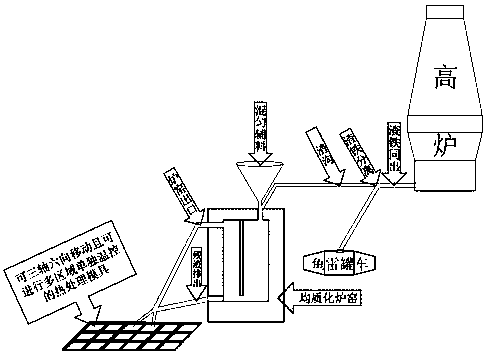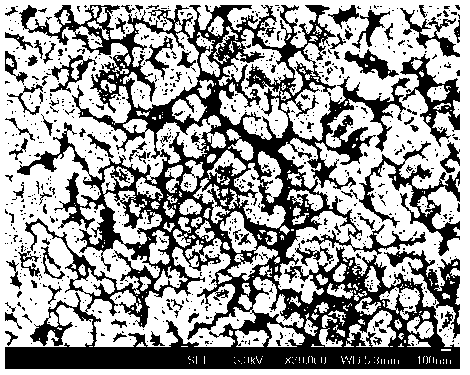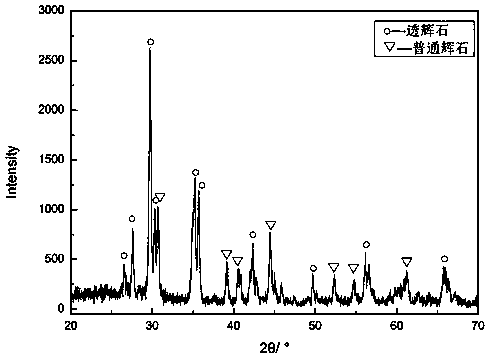One-step forming method of glass-ceramic plate by using molten blast furnace slag
A glass-ceramic and blast furnace slag technology, applied in glass forming, glass manufacturing equipment, manufacturing tools, etc., can solve the problems of high production cost, complex process, high energy consumption, etc., to reduce production cost and manufacturing cycle, simplify Preparation steps, the effect of avoiding energy waste
- Summary
- Abstract
- Description
- Claims
- Application Information
AI Technical Summary
Problems solved by technology
Method used
Image
Examples
Embodiment 1
[0030] (1) The amount of blast furnace slag is designed to be 37%, and the target composition (wt.%) of blast furnace slag glass ceramics is: CaO15%, SiO 2 50%, Al 2 o 3 12%, MgO10%, K 2 O3%, ZnO3%, TiO 2 5%, other components in blast furnace slag are ignored.
[0031] (2) The test results of the chemical composition of the blast furnace slag from the previous heat were CaO40.57%, SiO 2 34.15%, Al 2 o 3 15.88%, MgO7.88%, K 2 O0.57%, TiO 2 0.95%, the test result of this composition represents the chemical composition of the liquid blast furnace slag used this time. The liquid blast furnace slag used in the implementation of this example is 370g. After calculation, the required amounts of various auxiliary materials are: SiO 2 374g, Al 2 o 3 61g, MgO71g, K 2 O27g, TiO 2 46g, ZnO30g, these auxiliary materials are mixed, and together with the liquid blast furnace slag, they are quickly inserted into the constant temperature graphite crucible in batches. The graphite ...
Embodiment 2
[0035] (1) The amount of blast furnace slag is designed to be 61.6%, and the target composition (wt.%) of blast furnace slag glass ceramics is: CaO25%, SiO 2 40%, Al 2 o 3 12%, MgO10%, K 2 O3%, ZnO3%, TiO 2 5%, other components in blast furnace slag are ignored.
[0036] (2) The test results of the chemical composition of the blast furnace slag from the previous heat were CaO40.57%, SiO 2 34.15%, Al 2 o 3 15.88%, MgO7.88%, K 2 O0.57%, TiO 2 0.95%, the test result of this composition represents the chemical composition of the liquid blast furnace slag used this time. The amount of liquid blast furnace slag used in the implementation of this example is 616g. After calculation, the required amounts of various auxiliary materials are: SiO 2 190g, Al 2 o 3 22g, MgO52g, K 2 O26g, TiO 2 44 g, ZnO30g, mix these auxiliary materials, and quickly insert them into the constant temperature graphite crucible in batches together with the liquid blast furnace slag. The graphite ...
Embodiment 3
[0040] (1) The amount of blast furnace slag is designed to be 37%, and the target composition (wt.%) of blast furnace slag glass ceramics is: CaO15%, SiO 2 50%, Al 2 o 3 12%, MgO10%, K 2 O3%, ZnO3%, TiO 2 5%, other components in blast furnace slag are ignored.
[0041] (2) The test results of the chemical composition of the blast furnace slag from the previous heat were CaO40.57%, SiO 2 34.15%, Al 2 o 3 15.88%, MgO7.88%, K 2 O0.57%, TiO 2 0.95%, the test result of this composition represents the chemical composition of the liquid blast furnace slag used this time. The liquid blast furnace slag used in the implementation of this example is 370g. After calculation, the required amounts of various auxiliary materials are: SiO 2 374g, Al 2 o 3 61g, MgO71g, K 2 O27g, TiO 2 46g, ZnO30g, these auxiliary materials are mixed, and together with the liquid blast furnace slag, they are quickly inserted into the constant temperature graphite crucible in batches. The graphite ...
PUM
 Login to View More
Login to View More Abstract
Description
Claims
Application Information
 Login to View More
Login to View More - R&D
- Intellectual Property
- Life Sciences
- Materials
- Tech Scout
- Unparalleled Data Quality
- Higher Quality Content
- 60% Fewer Hallucinations
Browse by: Latest US Patents, China's latest patents, Technical Efficacy Thesaurus, Application Domain, Technology Topic, Popular Technical Reports.
© 2025 PatSnap. All rights reserved.Legal|Privacy policy|Modern Slavery Act Transparency Statement|Sitemap|About US| Contact US: help@patsnap.com



